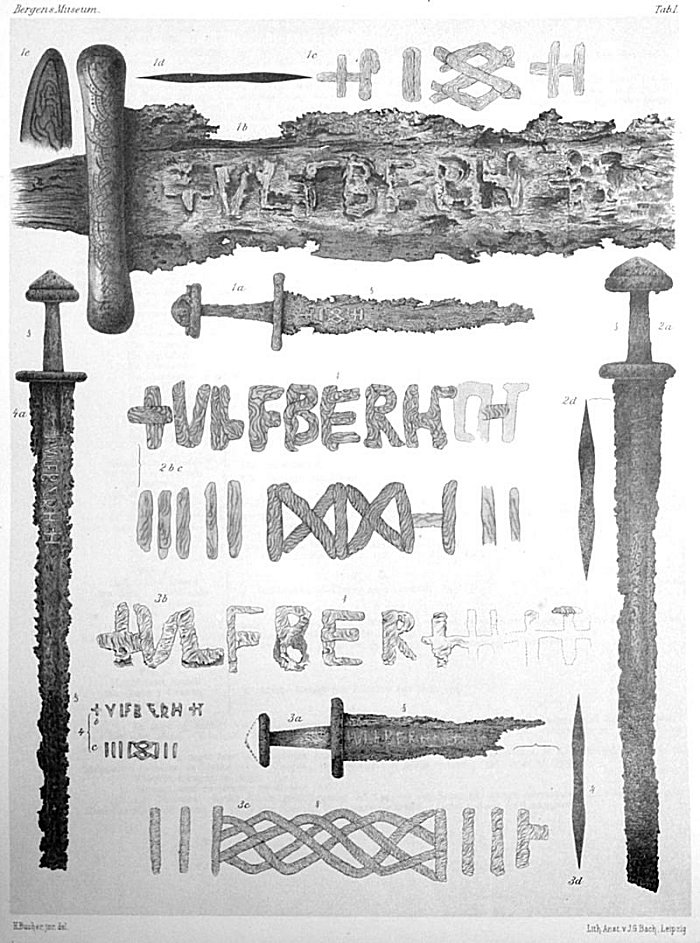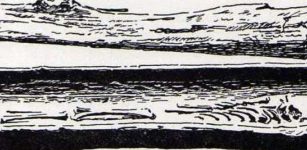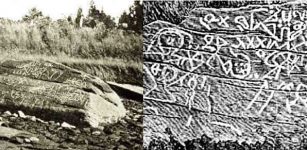Unravelling The Mystery Of The Ulfberht Sword – An Ancient Viking Artifact Far Ahead Of Its Time
Ellen Lloyd - AncientPages.com - Did Vikings possess superior ancient technology ahead of their time? Can archaeologists solve the puzzle of this old Scandinavian mystery?
Whose name is inscribed on this enigmatic ancient sword?
Digital model of an Ulfberht sword. Image credit: Dominic Zschokke - CC BY-SA 4.0
We may think we know a lot about Vikings. They are often portrayed as crude people that should be feared. We tend to forget that some of their ancient artifacts have remained a puzzle for years.
Among them, we find the mysterious Ulfberht sword, a very advanced weapon from thousands of years ago. Archaeologists have been trying to figure out how the Vikings could use such pure metal.
What made the Ulfberht blades so advanced?
Ulfberht swords were used in Scandinavia during the Viking Age. Ulfberht blades were made of crucible steel with relatively high carbon content, making them more robust and flexible than European swords during the Viking and Middle Ages. Archaeologists have discovered 171 such blades.
Crucible steel could not be produced in Europe until the Industrial Revolution in the 18th century. Still, in India, such steel (known as wootz, has been manufactured since 300 BC and has spread to large parts of the Middle East during the 9th century. Vikings probably gained access to the material from Persia via the trade route across the Volga and the Caspian Sea.
The design of these swords is similar to ordinary Viking swords and indicates that blades were forged in Europe, probably in the Frankish Empire.
 Four Ulfberht swords were found in Norway (drawings from Lorange 1889). Anders Lorange (died 1888). Public Domain
Four Ulfberht swords were found in Norway (drawings from Lorange 1889). Anders Lorange (died 1888). Public Domain
Ulfberht swords' metal was comparable to the strength of modern steel. At the same time, most Viking blades were composed of slag-ridden, low-carbon steel. The mystery was how the Vikings created these blades while the rest of Europe still made steel that could shatter like glass.
Up to now, about 170 Ulfberhts have been discovered, dating from 800 to 1,000 A.D.
How they were created is, therefore, an enigma. In the process of forging iron, the ore must be heated to 3,000 degrees Fahrenheit to liquefy, allowing the blacksmith to remove the impurities (called "slag").
Ulfberht's combination of strength, lightness, and flexibility was an advantage. Medieval blacksmiths in Europe didn't make slag-free steel because their fires weren't hot enough to liquefy the iron fully. In modern times, metals are melted at temperatures over 3,000 degrees.
It separates the slag and allows more carbon to be mixed in evenly. But in the Viking era, carbon could only be introduced incidentally, mainly through the coal in the fire, and the only way to remove the slag from the metal was to try to hammer out the impurities with each strike.
Of the thousands of European swords unearthed and dated to the Middle Ages, they all seemed to have been made from this inferior steel.
Dr. Alan Williams, an archaeometallurgist and consultant to the Wallace Collection, the London Museum, which has one of the best assemblies of ancient weapons in the world, analyzed the Ulfberht.
One of three Ulfberht swords found in the territory of the Volga Bulgars. Its hilt (classified as Petersen type T-2) is decorated with three lines of round holes inlaid with twisted silver wire. Image credit: Dbachmann - CC BY-SA 4.0
"The swords were far better than any other swords made, before or since, in Europe. And these must have been extraordinarily valuable to their contemporaries because of their properties.
One or two swords I looked at seemed to be different. They were made of steel, which I'd never seen in a medieval object before or since. This seems to be a completely different material.
The first thing that strikes you is that there are none of these long, grey slag inclusions, which make the metal brittle. The uniformity is more like modern steel than it is medieval one. And it has got a carbon content of about three times as much as the medieval steel we looked at a moment ago. I thought it was very odd. I couldn't think of a reason for it.
The material used was novel material, not found anywhere else in Europe in the middle ages," Dr. William says.
"The biggest mystery is where did they (the Vikings) get this raw material? We have no archaeological evidence of any crucible steel production in Europe until 800 years later," Richard Furrer asks in the NOVA documentary.
Scientists suspect the metal came from the Middle East.
Spatha, an Ulfberht sword, from the Rhine at Mannheim, 1st half of the 9th century, displayed at the Germanisches Nationalmuseum, Nuremberg. Image credit: Martin Kraft - CC BY-SA 3.0
"The interesting thing is that the most Ulfbehrt swords are dated from exactly the same time when the Volga trade route was open, that is from the early 800s to the mid-1,000s.
I think it's very likely that the steel you find in the Ulfberht swords originated from Iran. I would guess that you bought it from friendly trading connections in Iran, paid with furs and other Nordic commodities, and took it back on the small ships that you used on the rivers," says Fredrik Charpentier Ljungqvist, Secretary for the Centre of Medieval Studies at Stockholm University, Sweden.
The Vikings were among the fiercest warriors of all time. However, not many of them carried the Ulfberht sword. Created by using a process that would remain unknown to the Vikings' rivals for centuries, the Ulfberht was a revolutionary high-tech tool. It was also a real work of art. The swords were inscribed with the signature "+ULFBERH+T," but the origin of the name remains a mystery.
Considered one of the most excellent swords ever made, it remains a fearsome weapon more than a millennium after it last saw battle. How did Viking sword makers design and build the Ulfberht, and what was the weapon's role in history?
We have come one step closer to unraveling the mystery of the enigmatic Ulfberht Sword, but we still do not possess complete knowledge about this ancient Viking artifact.
Written by - Ellen Lloyd – AncientPages.com
Updated on January 21, 2024
Copyright © AncientPages.com All rights reserved. This material may not be published, broadcast, rewritten or redistributed in whole or part without the express written permission of AncientPages.com
Expand for referencessource:
Oakeshott R. Ewart, The Sword in the Age of Chivalry
More From Ancient Pages
-
 Ancient Dance And Games Offer Glimpses Of Life And Death In Italy 2,500 Years Ago
Archaeology | Mar 24, 2023
Ancient Dance And Games Offer Glimpses Of Life And Death In Italy 2,500 Years Ago
Archaeology | Mar 24, 2023 -
 The Incas Used Stringy Objects Called ‘Quipus’ To Record Data – We Just Got A Step Closer To Understanding Them
Featured Stories | Nov 26, 2024
The Incas Used Stringy Objects Called ‘Quipus’ To Record Data – We Just Got A Step Closer To Understanding Them
Featured Stories | Nov 26, 2024 -
 Ancient DNA Helps Reveal Social Changes In Africa 50,000 Years Ago That Shaped The Human Story
DNA | Jun 7, 2022
Ancient DNA Helps Reveal Social Changes In Africa 50,000 Years Ago That Shaped The Human Story
DNA | Jun 7, 2022 -
 1,700-Year-Old Roman Villa, Beautiful Mosaics, Coins Unearthed In Ancient Roman Port Of Ptolemais
Archaeology | Jun 12, 2017
1,700-Year-Old Roman Villa, Beautiful Mosaics, Coins Unearthed In Ancient Roman Port Of Ptolemais
Archaeology | Jun 12, 2017 -
 Excavations At Oylum Höyük In Southeast Anatolia Near Syrian Border – Resumed
Archaeology | Jul 26, 2020
Excavations At Oylum Höyük In Southeast Anatolia Near Syrian Border – Resumed
Archaeology | Jul 26, 2020 -
 On This Day In History: Spanish Conquistadors Led By Hernan Cortés Entered The Aztecs Capital Tenochtitlán – On Nov 8, 1519
News | Nov 8, 2016
On This Day In History: Spanish Conquistadors Led By Hernan Cortés Entered The Aztecs Capital Tenochtitlán – On Nov 8, 1519
News | Nov 8, 2016 -
 Evidence Of Beer Drinking 9,000 Years Ago In Southern China Discovered
Archaeology | Sep 1, 2021
Evidence Of Beer Drinking 9,000 Years Ago In Southern China Discovered
Archaeology | Sep 1, 2021 -
 Ancient Burial Of A Princess Who Fell Off A Cliff Raises Many Questions
Archaeology | Apr 18, 2019
Ancient Burial Of A Princess Who Fell Off A Cliff Raises Many Questions
Archaeology | Apr 18, 2019 -
 Remarkable Kailashanatha Temple And Unique Passage Of Life Cycle Including Aging, Death And Rebirth
Civilizations | Mar 26, 2017
Remarkable Kailashanatha Temple And Unique Passage Of Life Cycle Including Aging, Death And Rebirth
Civilizations | Mar 26, 2017 -
 Native American Sun Dance: Important Ceremony Of The Plains Indians Of North America
Ancient History Facts | May 20, 2016
Native American Sun Dance: Important Ceremony Of The Plains Indians Of North America
Ancient History Facts | May 20, 2016 -
 Ancient Wall Of Lolei Temple Built In 893 BC Unearthed In Siem Reap, Cambodia
Archaeology | Apr 20, 2020
Ancient Wall Of Lolei Temple Built In 893 BC Unearthed In Siem Reap, Cambodia
Archaeology | Apr 20, 2020 -
 Coronavirus: Advice From The Middle Ages For How To Cope With Self-Isolation
Featured Stories | Mar 29, 2020
Coronavirus: Advice From The Middle Ages For How To Cope With Self-Isolation
Featured Stories | Mar 29, 2020 -
 Historic Graffiti Made By Soldiers Sheds Light On Africa’s Maritime Heritage – New Study
Archaeology | May 6, 2022
Historic Graffiti Made By Soldiers Sheds Light On Africa’s Maritime Heritage – New Study
Archaeology | May 6, 2022 -
 Mythical Submerged City Of Ys – Europe’s Own Sodom And Gomorrah
Featured Stories | Feb 1, 2023
Mythical Submerged City Of Ys – Europe’s Own Sodom And Gomorrah
Featured Stories | Feb 1, 2023 -
 Secrets Of The Cathars – Mysterious Manuscript Of Jesus And His Pre-Flood Language
Featured Stories | Jan 18, 2019
Secrets Of The Cathars – Mysterious Manuscript Of Jesus And His Pre-Flood Language
Featured Stories | Jan 18, 2019 -
 Mysterious Maya Snake Kings And Their Powerful Kingdom In The Jungle Reveal More Ancient Secrets
Civilizations | Apr 23, 2018
Mysterious Maya Snake Kings And Their Powerful Kingdom In The Jungle Reveal More Ancient Secrets
Civilizations | Apr 23, 2018 -
 First Crusade Was Launched In 1095
Ancient History Facts | Jun 19, 2018
First Crusade Was Launched In 1095
Ancient History Facts | Jun 19, 2018 -
 Face Of Iron Age Female Druid Reconstructed
Archaeology | Aug 20, 2019
Face Of Iron Age Female Druid Reconstructed
Archaeology | Aug 20, 2019 -
 Dighton Rock – Centuries-Old-Mystery Still Unsolved
Featured Stories | Sep 8, 2015
Dighton Rock – Centuries-Old-Mystery Still Unsolved
Featured Stories | Sep 8, 2015 -
 Grandfather Frost And Snow Maiden Bring Gifts On New Year’s Eve
Christmas Traditions | Dec 31, 2024
Grandfather Frost And Snow Maiden Bring Gifts On New Year’s Eve
Christmas Traditions | Dec 31, 2024



